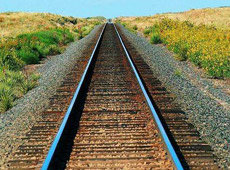

The connecting parts of railway sleepers include splints, bolts, nuts, washers, etc.
The function of the sleeper splint is to clamp the rail. At present, the splints used in standard rails in our country are double-ended, which are suitable for 60 kg/m rails and various types of rails. The diameter of circular bolt hole of splint is slightly larger than that of bolt, and the length of circular bolt hole is slightly larger than that of protruding part under bolt head. Depending on the difference between bolt hole diameter and bolt diameter, as well as the difference between circular bolt hole diameter and bolt diameter of splint, the rail can expand with the variation of rail temperature in the range of reserved rail joint value.
The bolt of sleeper should make the connection between rail and splint firm and reliable. It should fit tightly when it is in use, but it must be ensured that the splint can move in a certain longitudinal position when the rail temperature changes. The bigger the diameter of the bolt is, the stronger the fastening force is. However, to increase the diameter of the bolt, it is necessary to increase the bolt aperture of the rail and the splint, thus weakening the strength of the rail and the splint. Therefore, bolts should be made of high carbon steel and heat treated high strength bolts.
Train sleepers are currently jointed ordinary rails to meet the needs of rail thermal expansion and contraction. Rail joints are usually left with rail joints. Rail joints should not be too small, so as not to expand the track or bend or break the bolts when the rail is elongated at high temperature, but not too large, so as not to shrink and bend the rail and break the bolts at low temperature. Therefore, there must be reserved rail joints when laying rails.
The straight section of railway sleepers should be matched according to the rail error, and the difference on each rail should generally be no more than 3 mm. It should be offset from front to back and from left to right. On two rails, the maximum cumulative phase difference shall not be greater than 15 mm. When laying non-standard length rails or reusable rails and shortening rails without factory system, the rail joints can adopt staggered type, and the amount of phase errors should not be less than 3 m. When the length of the straight line between the two curves of the staggered joint is less than 300 m, the staggered joint can also be used in the straight line segment. The short rails inserted individually in the staggered form should be laid on the straight lines at both ends of the curve, and the inner strands of the curve can be laid under difficult conditions.



